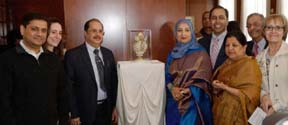
CHICAGO: Often described as “First Lady” of people of Indian of origin here, Farha Sayeed, the wife of Indian CG Dr. Ausaf Sayeed, may now be better described as the “First Indian Lady” to put India on the international map of Eggo artists by holding the first ever solo exhibition of her beautifully hand crafted, hand sculpted and painted eggs of different birds at the Chicago Symphony Orchestra Center in Chicago Downtown.
Even while it was Sunday morning and the weather still pretty cool, hundreds of her friends, admirers and art lovers from all walks of life came to attend this grand exhibition and wished that she may organize more such exhibitions of her art here. Very interestingly, Farha Sayeed in her welcome address to the gathering announced that a portion of the proceeds from the sale of her top of the class art items will be utilized for the benefit of the humanitarian project that the American India Foundation has been carrying on in India for years. The AIF initiative has been in the new born and maternal area for the past many years but the problem is huge and needs steady support.
Sunthar Visuvalingam adds:
India’s only egg-artist Farha Sayeed inaugurated the two-day public display of her unique work at the Chicago Symphony Center March 20. It was co-hosted by Zain and Lubaina Raj, with part of the sale proceeds going to support their American India Foundation’s Maternal and Newborn Survival Initiative (MANSI). Representatives of the Illinois Governor, Chicago Mayor, etc., were present along with local elite Desis and community members. Many local artists could be seen in the gathering, and the March 20 evening reception saw visiting tabla-maestro Zakir Hussain as guest of honor.
Farha, who has been experimenting with various materials since her youth, has a passion for creating Faberge-styled exotic art objects from egg shells of ostrich, rhea, emu, goose, duck, turkey, guinea and hen. First exposed to egg-art more than 17 years ago in Qatar, Farha has pioneered in introducing typically Indian motifs, both Islamic and Hindu. Each eggshell is intricately cut, carved and decorated by hand and ornamented using pearls, beads, crystals, brocade, velvet, satin, golden laces and rhinestone chains, making each a one of its kind masterpiece.
Techniques also include decoupage, trolling, etching, engraving, dyeing and bead work. Reinforced with liquid polymer to prevent shattering, the shells preserve their natural beauty. Farah’s collection of decorated eggs has been previously displayed at a series of full-fledged solo exhibitions in Copenhagen, Jeddah, New Delhi, Sana’a (Yemen), etc., to great appreciation.
Though the ancient notion of the primordial egg (brahmaanda) is central to Vedic-Hindu cosmogony as source of all creation, it has paradoxically befallen an enquiring Indian-Muslim to appropriate this Western art-form and indigenize it into an individual expression of her own unique creativity. Farah’s fertile imagination carves and chisels the pure smooth monochrome symmetry of the ovoid into an explosion of shapes and colors that represents the familiar things of our world and also invokes the formless transcendent.
Her “Nirvana” for example consists of three different shells-ostrich, rhea, goose-each enclosing the following one; intricately carved into hinged petals, they open out to suggest the otherwise indescribable experience of enlightenment that accompanies the blossoming of the thousand-petaled lotus.
In minimalist calligraphic representations such as “Almighty Will,” “Words of Purity” and “Divine Force” the egg, in its white purity or especially (emu) blackness, assumes the austere bareness of the Kaaba stone. This is in sharp contrast to her ‘eggstravagaza’ in portraying Western or decorative motifs, for example when transformed into the body of a carriage, especially that of Cinderella.
Indian motifs comprise Mughal portraiture, exemplified by the “Eternal Love” of Mumtaz and Emperor Shah Jahan on opposing sides of the rounded surface, and by Padmini.
Practical use is not merely suggested through pot, cups and accompanying vessels of tea sets, but implemented as lidded caskets to hold jewelry. Other pieces simply play with the surprising shapes of variously cut out shells as in the celebration of “Whirling Beauty.”
As member of the International Egg Art Guild (IEAG), Farha represented India as it were at the 40th Annual Eggs-Ibit International 2014 held in Dallas last June. The significance of her ‘eggspression’ goes well beyond art for it integrates diverse elements, motifs and uses, practical and fantastic, religious and profane, foreign and native, into the contemporary mosaic of Indian culture.
In her own independent and original way, it complements very well the untiring diplomatic work of her husband, Consul-General Dr. Ausaf Sayeed, in rallying Chicagoland’s diverse Diaspora communities and reaching out to various constituencies in the host society around a shared love for and investment in India and its future.
Ramesh Soparawala & Sunthar Visuvalingam
India Post News Service






